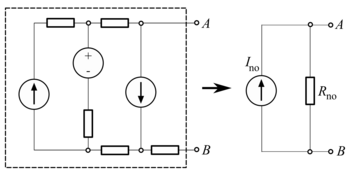

In direct-current circuit theory, Norton's theorem, also called the Mayer–Norton theorem, is a simplification that can be applied to networks made of linear time-invariant resistances, voltage sources, and current sources. At a pair of terminals of the network, it can be replaced by a current source and a single resistor in parallel.
For alternating current (AC) systems the theorem can be applied to reactive impedances as well as resistances. The Norton equivalent circuit is used to represent any network of linear sources and impedances at a given frequency.
Norton's theorem and its dual, Thévenin's theorem, are widely used for circuit analysis simplification and to study circuit's initial-condition and steady-state response.
Norton's theorem was independently derived in 1926 by Siemens & Halske researcher Hans Ferdinand Mayer (1895–1980) and Bell Labs engineer Edward Lawry Norton (1898–1983).[1][2][3][4][5][6]
To find the Norton equivalent of a linear time-invariant circuit, the Norton current Ino is calculated as the current flowing at the two terminals A and B of the original circuit that is now short (zero impedance between the terminals). The Norton resistance Rno is found by calculating the output voltage Vo produced at A and B with no resistance or load connected to, then Rno = Vo / Ino; equivalently, this is the resistance between the terminals with all (independent) voltage sources short-circuited and independent current sources open-circuited (i.e., each independent source is set to produce zero energy). This is equivalent to calculating the Thevenin resistance.
When there are dependent sources, the more general method must be used. The voltage at the terminals is calculated for an injection of a 1 ampere test current at the terminals. This voltage divided by the 1 A current is the Norton impedance Rno (in ohms). This method must be used if the circuit contains dependent sources, but it can be used in all cases even when there are no dependent sources.
- ^ Cite error: The named reference
Mayer_1926was invoked but never defined (see the help page). - ^ Cite error: The named reference
Norton_1926was invoked but never defined (see the help page). - ^ Cite error: The named reference
Johnson_2003awas invoked but never defined (see the help page). - ^ Cite error: The named reference
Johnson_2003bwas invoked but never defined (see the help page). - ^ Cite error: The named reference
Brittain_1990was invoked but never defined (see the help page). - ^ Cite error: The named reference
Dorf_2010was invoked but never defined (see the help page).